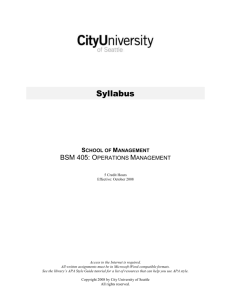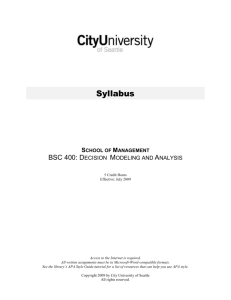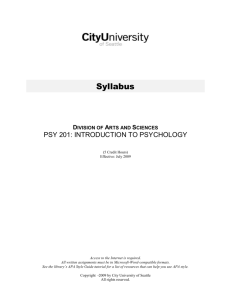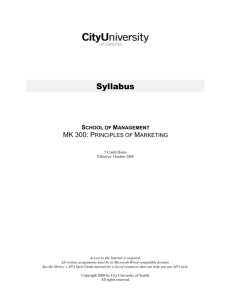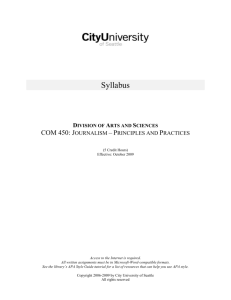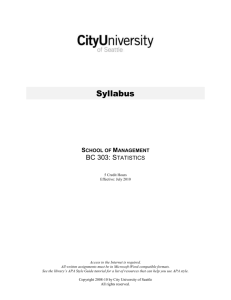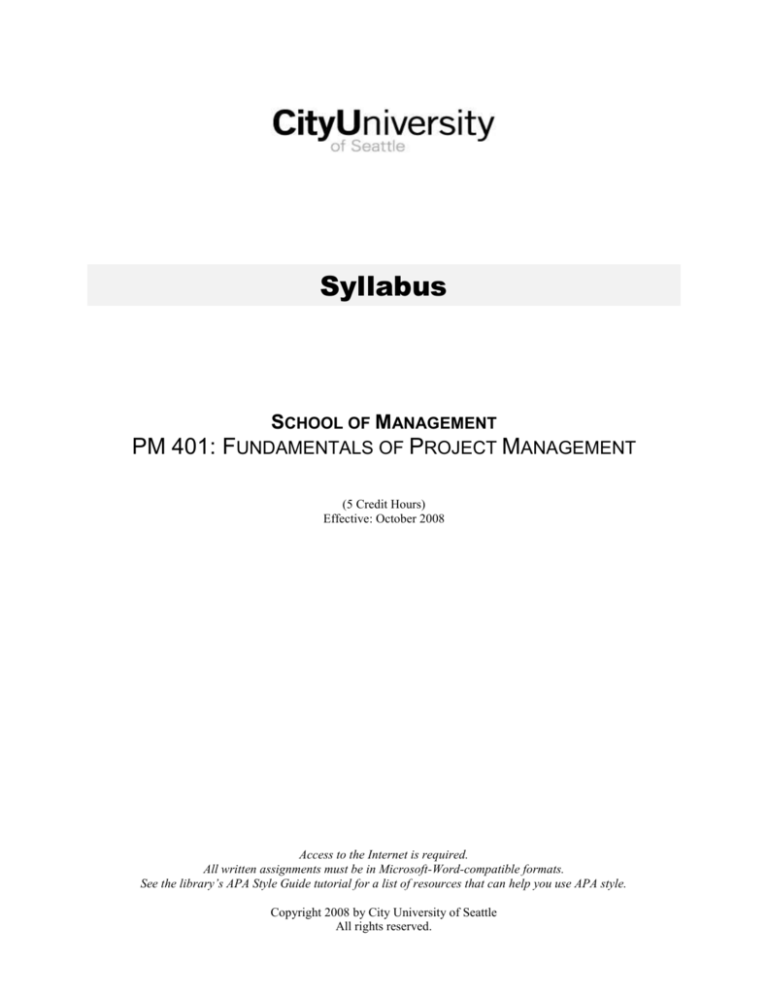
Syllabus
SCHOOL OF MANAGEMENT
PM 401: FUNDAMENTALS OF PROJECT MANAGEMENT
(5 Credit Hours)
Effective: October 2008
Access to the Internet is required.
All written assignments must be in Microsoft-Word-compatible formats.
See the library’s APA Style Guide tutorial for a list of resources that can help you use APA style.
Copyright 2008 by City University of Seattle
All rights reserved.
PM 401: FUNDAMENTALS OF PROJECT MANAGEMENT
FACULTY
Faculty Name:
Contact Information:
[Instructor may insert personal message if desired]
COURSE DESCRIPTION
PM 401, Fundamentals of Project Management, utilizes a simulated team project to manage a project’s
life cycle. Emphasis is placed on activity networks, managing resources, and creating control
mechanisms that minimize risk. Project leadership is explored in the context of building effective project
teams and maintaining stakeholder relationships. Students will learn and apply basic project management
concepts including triple constraint, planning, scheduling, work breakdown structures and project control.
City University Learning Goals: (1) professional competency and a sense of professional identity; (2)
strong communication and interpersonal skills; (3) critical thinkers.
There are no prerequisites for this course.
COURSE RESOURCES
Required and recommended resources to complete coursework and assignments are listed on the
My.CityU portal at Library>Resources by Course.
CITYU LEARNING GOALS
This course supports the following City University learning goals:
professional competency and a sense of professional identity;
strong communication and interpersonal skills;
critical thinking.
PROGRAM CONTEXT
This course, as part of the project management emphasis area for the BSBA program, introduces students
to the basic tools and processes of project management.
The content of this course aligns with the following program outcomes:
Recommend improvements that align with the company’s strategy, goals, and culture.
Lead and manage diverse teams.
(PM 401)
Page 2
Eff: 10/08
COURSE OUTCOMES
In this course learners will …
become familiar with and be able to apply the following PM tools: SOW, WBS, Network
Diagram, Cost and Schedule Estimating, BBS, SWOT, RBS, and apply cost and schedule
controls;
be able to explain the project life cycle and the activities within each phase of the cycle;
be able to appropriately resource load a project.
CORE CONCEPTS, KNOWLEDGE, AND SKILLS
The student will be able to define and demonstrably apply the following terms and processes:
Budget breakdown structure;.
Cost and Schedule Estimating;
Emotional intelligence;
Project Charter and Mission;
Project Life Cycle;
Project Network Diagram;
Project Progress / Performance Measures;
Project Resource Loading;
Project SOW;
Project WBS;
Risk Breakdown Structure;
SWOT.
OVERVIEW OF COURSE GRADING
The grade you receive for the course will be derived using City University of Seattle’s decimal grading
system, based on the following:
Overview of Required Assignments
Case Study
Team or Individual Project
Midterm Examination
Final Examination
Instructor Determined Assignments(Also Including Participation)
TOTAL
% of Final Grade
20%
25%
20%
25%
10%
100%
SPECIFICS OF COURSE ASSIGNMENTS
Your instructor will provide grading rubrics that will provide more detail as to how this assignment will
be graded.
(PM 401)
Page 3
Eff: 10/08
DISCUSSION QUESTIONS
Each week a discussion question or topic will be placed in the Discussion Board for your response. You
are to research material in your text and other sources and post an initial response as well as a response to
at least two other classmates prior to the start of the next class. Your responses should have substance,
demonstrate critical thinking, and demonstrate your grasp of the course’s material. Each response should
be approximately 300 to 350 words in length that provide insight, substance and reflect a respectful,
supportive spirit.
Each response should demonstrate proper grammar, spelling, syntax, and punctuation. Your style should
be lucid, expressive, and easily read.
All responses are to be posted to the BlackBoard learning management system. It is advisable to post your
original response by mid-week to allow other students time to read and digest your words and respond to
you. All responses are due by midnight prior to the next class session.
If you have a question or comments meant specifically for your instructor, contact your instructor
directly. If you have questions related to the course, use the Question and Answer Forum in the
Discussion Boards Section of the Blackboard shell. If you want to talk about issues unrelated to the
course material, use the Coffee Talk Forum found in the Discussion boards Section of the Blackboard
shell. This is a great place to mingle and get to know each other better.
Grading Criteria for Discussion Questions
Components
Appropriateness and Quality of Responses (one original and
two additional responses required)
Quantity of Research indicated in responses.
TOTAL
% of Grade
60%
40%
100%
CASE STUDY
Your instructor will assign a case or give you guidelines to use in selecting a case for analysis. A case
analysis is designed to help you sharpen your analytical skills. The strongest way to analyze a case is to
apply a variation of the scientific method. This method of analysis is simply a logical approach that
usually includes the seven steps outlined below.
The components of a case study are:
Summarize case.
Identify and define central problem or problems.
Justify problem(s) definition.
Identify potential solutions.
Reframe (analyze) key elements of case, paying particular attention to the efficacy of your
potential solutions.
Propose a specific solution.
Justify your specific solution.
Develop a plan for implementing and evaluating your proposed solution.
(PM 401)
Page 4
Eff: 10/08
Step 1: Summarize the Case
•
•
•
Study the case. Take extensive notes on events, issues, relationships, actions and reactions.
When intimately familiar with case, write a summary focusing on events, decisions, actions and counter
actions.
Be succinct, avoid of extraneous details.
Step 2: Identify and define central problem or problems.
•
•
•
•
Diagnose predecessor events symptomatic of dysfunction.
Distinguish between “presenting” symptom(s) and cloaked symptom(s).
Frame the definition, remembering definition suggests a solution.
Cite scholarly studies to support your identification and definition. Studies should relate to the central
concepts for the specific course for which the case study is being prepared.
It is important to separate the immediate problems from their more basic sources. For example, the
immediate problem may be a high rate of absenteeism, while the more fundamental issue may be a poor
motivational climate. How you define a problem determines how you go about solving it. A short-term
solution for absenteeism is likely to be different from solutions which attempt to deal with motivational
climate. Be sure to identify both the symptom and, more importantly, its underlying cause.
Step 3: Justify problem(s) definition.
•
•
•
Present factual evidence drawn from the case and your inferences.
Inferences must be congruent with events in the case and logically drawn from both the presenting and
cloaked symptoms.
Inferences should be supported by scholarly research and directly relate to course concepts and events in
the case.
Step 4: Identify potential solutions.
•
•
•
Document potential solutions to the problem, ensuring that each logically flows form the problem
definition.
Each potential solution is supported by scholarly research that addresses the problem.
Potential solutions should reflect integration of course concepts and scholarly research.
Step 5: Reframe (analyze) key elements of case, paying particular attention to the efficacy of your
potential solutions.
•
•
Reframe the key elements of the case, paying particular attention to the efficacy of your potential
solutions and their relationship to the problem as defined.
Reframing is a re-capitulated summary that expresses your conclusions based on fact, inference, course
concepts, and scholarly research.
Step 6: Propose a specific solution.
•
•
Based on your reframing and review of potential solutions, course concepts and scholarly research, make
a specific recommendation that addresses both the manifested and cloaked symptoms in the case.
The specific recommendation may combine several of your proposed solutions.
(PM 401)
Page 5
Eff: 10/08
Step 7: Justify your specific solution.
•
Support you specific recommendation or combination of recommendations by citing scholarly research
from at least three different scholars.
Step 8: Develop a plan for implementing and evaluating your proposed solution.
•
•
Develop a plan for implementing (e.g., a Gantt chart) and evaluating (e.g., control plan) your proposed
solution.
Any plan should be well documented and reflect support for your strategy and tactics from the scholarly
research and reflect a clear understanding of the course’s central concepts.
Grading Criteria for Case Study
Component
Explanation
% of
Grade
25
Integration of course
concepts.
Completeness of
analysis.
Demonstrated application of course concepts to the case, proposed
solutions, and implementation and evaluation plan.
Demonstrated critical thinking, reflection, and application of
relevant literature to the case, ensuring that all elements are covered.
Logically supported
conclusions and
recommendations.
Bibliographic
support.
Grammar and
syntax.
All case study process flow elements are judiciously followed and
applied with academic rigor in a way that demonstrates conceptual
precision.
Clear evidence that the relevant literature was reviewed and applied.
25
Demonstrated writing skill that includes all aspects of the written
language. This includes how clearly ideas and concepts are
expressed.
Total
10
30
10
100
TEAM PROJECT
This project is designed to give you and your teammates the chance to practice using the various project
management tools and processes as you construct an architectural model of a house (in-class) or develop a
plan from a house drawing (on-line) and a supporting project notebook/portfolio.
The project will be due during the ninth week. Each team will be required to present the outcome of their
project to the class. Each team will submit two end items for grading. The project notebook is more
heavily weighted than the architectural model.
Grading Criteria for Team Project
Component
Integration of course concepts
Explanation
Demonstrated application of course concepts to the
specific case study selected, student’s proposed
(PM 401)
Page 6
Eff: 10/08
% of
Grade
30
solutions, and the conceptual precision of their
implementation and evaluation plan.
Demonstrated critical thinking, reflection, and
application of relevant academic literature to the
case, ensuring that all elements of the case are
covered.
Architectural model is well laid out and follows the
Project Charter guidelines. All project notebook
elements must be present, although sequencing
may vary
Demonstrated writing skill that includes all aspects
of the written language. This includes how clearly
ideas and concepts are expressed and adherence to
APA (5th ed.) requirements.
Completeness of analysis and
logical presentation of all required
elements
Logical plan and correct use of all
planning elements
Spelling, grammar, punctuation,
and format
TOTAL
30
30
10
100
MIDTERM AND FINAL EXAMINATIONS
Be prepared to answer a variety of questions pertinent to course content and assignments. Your instructor
will provide additional information on how exams will be administered.
Grading Criteria for Essay Questions on Examinations
Comprehension:
Analysis,
Synthesis, and
Application:
Supporting
Research:
Organization and
Structure:
Grammar and
Syntax:
A clear grasp of the issues posed by the questions, evidenced with
valid, cogent arguments that demonstrate appropriate detail directly
relate to the question as asked.
Demonstrated application of course concepts to the question as asked.
Demonstrated critical thinking, applied to all elements of the question
as asked.
Clear evidence that question-relevant literature, concepts, frames of
reference and other course materials were utilized.
Logical flow and conceptual precision is evident in an exam that is well
integrated as a embodied whole and it adherence to APA (5th ed.) style
guidelines.
Demonstrated writing skill in all aspects of the written language.
TOTAL
25%
25%
25%
15%
10%
100.%
COURSE POLICIES
Late Assignments
Students are expected to meet submission requirements for assignments in a timely manner. Evaluation
includes an assessment of timeliness. Late assignments jeopardize your learning, and may also for your
classmates.
A 10%, per each day late, penalty will be assessed for all late work. All assignments MUST be turned in
no later than the last session of the course.
(PM 401)
Page 7
Eff: 10/08
[Instructor may insert his or her policy on late assignments if desired]
Participation
Students are expected to be actively engaged in a discussion or other activities. Active engagement
means contributing substantive, thoughtful and reflective responses. If online, students must post their
initial responses during the first three days of the week, and their responses to other students’ postings
during the last four days of the week.
Professional Writing
All assignments for this course should be of professional quality. The writing should always take into
consideration the intended audience. Hand written work will not be accepted.
This course requires you to use the American Psychological Association (APA) style in preparing any
required research papers, or any written work where other sources are used. References should be cited
for all facts, ideas, conclusions, and opinions that are not your own.
A proper title page should preface all written assignments, unless otherwise stated. The title page should
include: your name, the title of the paper, the name and number of the course, your course start date, the
date submitted, and the name of the instructor.
Your work should be typed or word-processed on white 8 ½ by 11 inch paper. Any narrative sections
should be double-spaced. Some assignments many require that your work be prepared on a computer
spreadsheet.
UNIVERSITY POLICIES
You are responsible for understanding and adhering to all of City University of Seattle’s academic
policies. The most current versions of these policies can be found in the University Catalog that is linked
from the CityU Web site.
Scholastic Honesty
Scholastic honesty in students requires the pursuit of scholarly activity that is free from fraud, deception
and unauthorized collaboration with other individuals. You are responsible for understanding CityU’s
policy on scholastic honesty and adhering to its standards in meeting all course requirements. A complete
copy of this policy can be found in the University Catalog in the section titled Scholastic Honesty under
Student Rights & Responsibilities.
Attendance
Students taking courses in any format at the University are expected to be diligent in their studies and to
attend class regularly.
(PM 401)
Page 8
Eff: 10/08
Regular class attendance is important in achieving learning outcomes in the course and may be a valid
consideration in determining the final grade. For classes where a physical presence is required, a student
has attended if s/he is present at any time during the class session. For online classes, a student has
attended if s/he has posted or submitted an assignment. A complete copy of this policy can be found in
the University Catalog in the section titled Attendance Policy for Mixed Mode, Online and
Correspondence Courses.
SUPPORT SERVICES
Disability Resources
If you are a student with a disability and you require an accommodation, please contact the Disability
Resource Office as soon as possible. For additional information, please see the section in the University
Catalog titled Students with Special Needs under Student Rights & Responsibilities.
Library Services
In order to help you succeed in this course, you have access to library services and resources 24 hours a
day, seven days a week. CityU librarians can help you formulate search strategies and locate materials
that are relevant to your coursework. For help, contact a CityU librarian through the Ask a Librarian
service. To find library resources, click on the Library link in the My.CityU portal.
Smarthinking
As a CityU student, you have access to 10 free hours of online tutoring offered through Smarthinking,
including writing support, from certified tutors 24 hours a day, seven days a week. Contact CityU’s
Student Support Center at info@cityu.edu to request your user name and password.
(PM 401)
Page 9
Eff: 10/08

